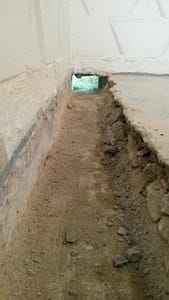Our Best Basement Waterproofing Ideas
Our Best Basement Waterproofing Ideas
Blog Article
Some Ideas on Best Basement Waterproofing You Should Know
Table of ContentsWhat Does Best Basement Waterproofing Do?How Best Basement Waterproofing can Save You Time, Stress, and Money.The 6-Second Trick For Best Basement WaterproofingThe smart Trick of Best Basement Waterproofing That Nobody is Talking AboutEverything about Best Basement Waterproofing
AdvantaClean's trained specialists and professionals will certainly locate the water source. If wall surface or slab fractures are existing, we will certainly inject polyurethane and epoxies right into the splits and seal the concession, preventing additional wetness from getting in.Proper rating around the home to guide moisture away from the framework. Setting up, repairing, or cleansing gutters and downspouts. Interior or outside waterproofing with filler, sealer, and/or water-proof paint. Mounting cellar ventilation systems, conditioning systems, or basement dehumidifier systems to obtain water out of your basement. Choosing AdvantaClean's basement waterproofing services is a reliable method to deal with dampness and avoid mold and mildew from endangering the framework of your home and the wellness of your family.
If there's condensation on the exterior of the aluminum foil, you have high moisture in your cellar. Repair it with a mobile area dehumidifier or a whole-house humidifier system rather than waterproofing items. If the aluminum foil has condensation on the inside surface area (beside the wall), the dirt around your home may be normally damp from a high water table or inadequate dirt drainage.
You can waterproof simply your indoor wall surfaces, which might fix the issue. Or you can waterproof your exterior walls, which is a much better wager however more expensive. Here's the scoop on the different types: These thick coverings are cement-like. Once they dry out, they stick completely to concrete and stonework wall surfaces.
A Biased View of Best Basement Waterproofing
Concrete waterproof coatings can't be applied to previously painted surface areas; check the label. Understood as densifiers, they are appropriate only for walls that haven't been repainted or secured.
Yet you comb, roll, or spray it on a lot more thickly one gallon covers just 75 square feet, not the 300 square feet typical with common paint. Waterproof paint is great for do it yourself application. You can apply it over repainted surfaces, and paint over it once it's cured (one gallon prices $37).
It can cost $10,000 to $15,000, relying on the work needed. Outside waterproofing involves digging deep into all over your home to the full deepness of the structure walls, then setting up a waterproof layer or membrane covered by drainage panels. The panels give a very easy course for water to flow down to an outside French drain have a peek at this website at the base of your foundation.
Best Basement Waterproofing - Truths
We have actually all been caught in a tornado with no umbrella or raincoat. And it's constantly a recipe for catastrophe: everything's damp, your coiffure is wrecked, and things are obtaining stuffy. A cellar without waterproofing is type of like that. Minus the wrecked hairdo component. Your basement does not intend to undergo a rainstorm without proper security just as high as you do not want to.
Exterior waterproofing is a waterproofing approach that entails securing your home from the exterior. It's kind of like a moat around a castle. It entails excavating a trench around your whole home down to the structure (concerning 8 to 10 feet down). The structure walls are after that cleaned, secured, and covered with a water resistant membrane layer or sealer.

Indicators on Best Basement Waterproofing You Should Know
It's a more engaged procedure that calls for digging up your lawn, which is costly and lengthy. Outside waterproofing involves removing everything surrounding the residence, including verandas, driveways, pathways, landscape design, AC devices, decks, and so on. If any of the work was done inaccurately and water is still entering your cellar, there isn't much you can do to deal with or repair it.
Inside cellar waterproofing involves waterproofing from the inside. Any water that leaks right into your basement is redirected before it touches your flooring.
It's an effective technique to water-proof your basement. The downside of indoor cellar waterproofing mostly has to do with the setup process.
An Unbiased View of Best Basement Waterproofing
To conclude, exterior and interior cellar waterproofing are both effective techniques of shielding your home from water damage. Outside waterproofing creates a barrier that protects against water from entering your home, while indoor waterproofing redirects water that does enter your home. And it is very important to note that outside waterproofing is an expensive and disruptive installation process when contrasted to indoor waterproofing.
Whichever method you select, see to it you pick a trusted and credible professional for the job. Both methods require experienced employees to handle the job. If you have any inquiries concerning basement waterproofing, please reach out to us. And if you remain in our service area and have water in your cellar, contact us for a cost-free, no-obligation home inspection.
You can complete our form here. Best Basement Waterproofing, start a conversation in the lower right-hand corner, or call us at 1-800-827-0702
Report this page